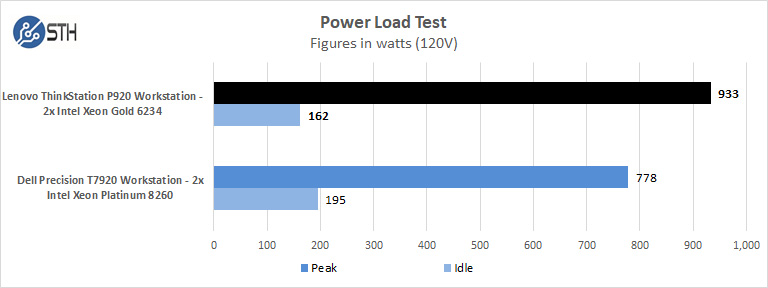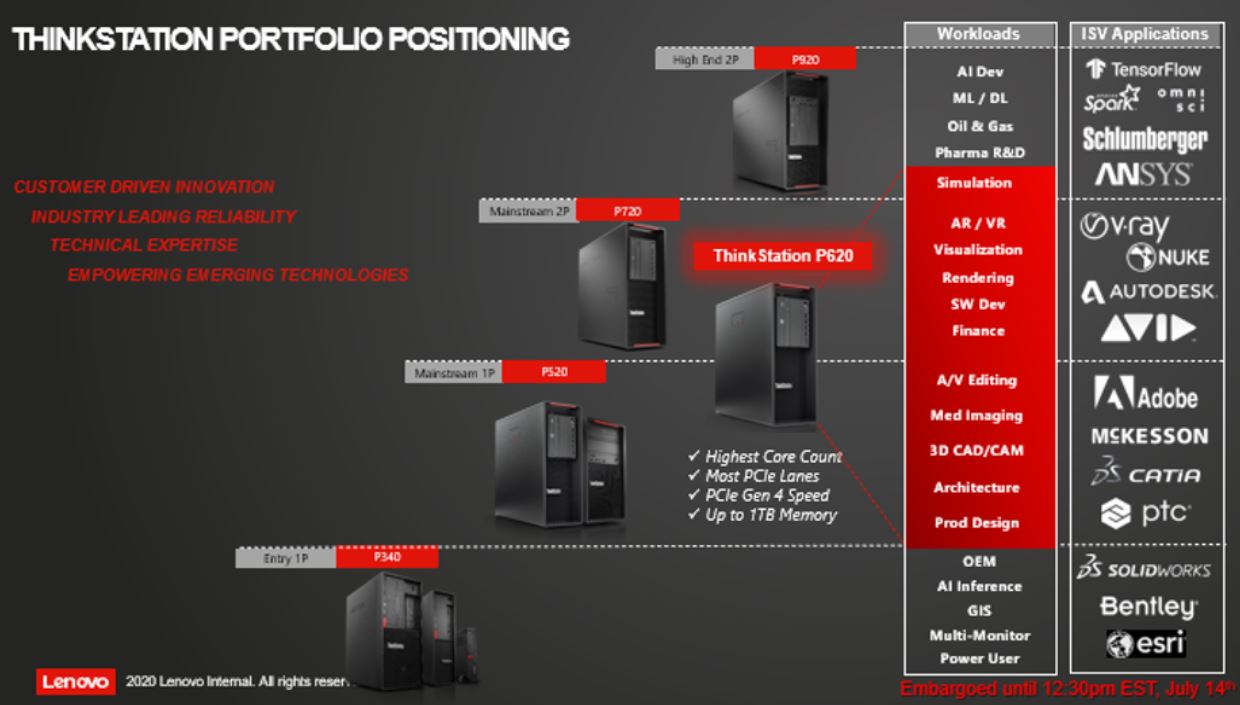Lenovo ThinkStation P920 Tower Power Load Tests
Power consumption can vary a significant amount depending on processors used and the number of HDDs/SSDs/Expansion cards used. Here we test just a primary system. We test with the same graphics cards and NVMe SSD in all our tests. Power is measured at the wall.

For our tests, we use the AIDA64 Stress test, which allows us to stress all aspects of the system. Our Lenovo ThinkStation P920 Tower Review pulled 933watts at the wall when under full load and idled at 165watts. Dual Quadro RTX 8000’s in NVLINK generate more power use when stressed vs. a single GPU. Our Dual Xeon Gold 6234 CPU’s idle at a lower wattage then Dual Xeon Platinum 8260’s results in lower idle power use.
- OS Idle: 162W
- AIDA64 Stress Test: 933
The cooling system of the Lenovo ThinkStation P920 Tower Review did perform well, and fans did noticeably spin up at higher loads. Fan noise was low at idle, and even during moderate workloads, it was hardly noticeable, during peak workloads the fans could be heard but not at the extreme levels we have heard with other manufacturers 4U workstations. We had no issues sitting next to the system while testing.
That is important since these systems often need to sit desk-side where loud systems can hinder both the employee working on them as well as those around them.
Final Words
We took a fairly extensive look at the ThinkStation P920. That means we tested a configuration through a number of different workloads. If, for example, you were not bound by per-core licensing, then the Xeon Gold 6234’s found in this unit would not have made as much sense as some of the newer and higher-core count Xeon offerings. Overall, the pairing of the Quadro RTX 8000 GPUs with dual Xeons positions this at the top-end of Lenovo’s workstation range, even with the new Lenovo ThinkStation P620 being announced.

As one might expect, a Lenovo ThinkStation P920 Tower configured as our review unit is pricey, with a base price as it was equipped for our review of $39,899! That is sticker shock for sure. However, on Lenovo’s website, we spot significant savings that can be found at a discounted price of $27,929. For those who have corporate purchasing deals with Lenovo, and those who have a Lenovo sales rep, we may suggest that online pricing is often higher than street pricing once customary discounts are applied. Naturally, when one needs dual NVIDIA Quadro RTX 8000’s for work, these machines can be costly but make up for it in pure graphics horsepower resulting in increased productivity.
What sets the Lenovo ThinkStation P920 Tower above the pack is its complete tool-less feature set, it is a simple task to get inside the P920 and install or swap out components. The design of the P920 case is also a classic, simple, elegant, and even with its large size, it is an effortless task moving the workstation around with handholds in easy reach. One also gets the on-site service from Lenovo and if you are an existing Lenovo customer, this is an easy choice for this class of machine.




P620 looks to be the better, cheaper, faster option with a drawback that’s it’s not available at the moment.
Looks to be a swan’s song of xeon/lenovo workstation especially after p620 was already announced. The only question is if p620 will be half or one third of the p920 price.
Anyway, pity AMD is saving this for OEMs since if it would be in general market, man would be able to build even cheaper WS.
So sorry, why is the P620 not rubbing shoulders with the P920?
40k !!! No way
Everybody blaming Apple for their pricey workstations.
But, simply put, horsepower is expensive.
When you go for professional workstation the order of magnitude is well above 25-30k.
Apple, although more expensive seems not too far from this price tag.
(writing this from my lenovo notebook which is great :-) )
Their airflow design is rather poor though, second cpu heats up quite a lot more and higher than seems reasonable, because of that the rear fan goes bonkers and it is Very loud, now imagine an office space with 30 of these
Wonder if Intel actually paid or otherwise leveraged Lenovo somehow to segment the Threadripper in the 600 series of their Workstation range. After all, to the clueless exec that is going to be signing off on these, 920 is exactly 300 more than 620, and the morer the betterer, like always.
P620 is about 5x more desirable in all real world scenarios I can think of.
Unfortunately, this doesn’t matter at all. These workstations sung their songs, and it’s game over for them anyway (willing to bet they will bleed a lot of market share in the next years). Everybody I know in my industry (Turbomachinery, heavy ANSYS users) say they got switched to mobile workstations in the last couple of years (myself included), and pointed towards local HPC cluster, or worse yet – AWS, for heavy lifting.
You can imagine with COVID and WFH trends, it’s just going to become even worse for the big ol’ boxes.
Too bad. I really like them. And no, working on a cluster can never feel* as fast, snappy and productive as working on your local beast.
*subjectively, OFC
@Turbo
That and when media outlets use “Truly Top End” Workstation as their tagline and then a muted “first” for the competitor, it really highlights the focus on one to the other.
It seems such a cold shoulder when the only reasons to not put the 620 up higher on the list are 600GB less memory and per core licensing models…
“Lenovo ThinkStation P920 Review A Truly Top-End Workstation”
A truly top-end in price, compared with P620?
Hi William,
this is pendantry, and not at all necessary for comprehension, but may I be allowed to suggest a easier scan for your punctuation of your introductory paragraph?
Thus:
“Lenovo has updated its classic ThinkStation P910 Tower we reviewed three years ago. With the latest processors and GPU’s equipped in our P920, let us jump into it and see how these new machines perform and all of the features Lenovo includes in its ThinkStation P920.”
Potentially might be more easily read, after the following very minor editing:
“Lenovo has updated its classic ThinkStation P910 Tower, which we reviewed three years ago, with the latest processors and GPU’s equipped in our P920.”
“Let’s jump into it and see how these new machines perform, and all of the features Lenovo includes in its ThinkStation P920.”
Mischa,
The last time I wrote a PO for IBM Xeon w/s we ended up getting the machines subsystem by subsystem stowed in carry on from Armonk because our tiny order languished in someone’s in tray depths for a few months unti we realised that IBM was still under a consent order to not offer for sale anything not available from stock for delivery. The legacy of the Seven Dwarves slain by vaporware deposit taking for frames still on the drawing board expired iirc in ’05 after 50 years.
I’m recalling this because – STH notices aside – the general market is increasingly disenfranchised and segregated from the state of the art in ways that I am increasingly certain are highly prejudicial to our scale competitiveness. The pecking order doesn’t even seem to confer any embarrassment upon the industry and I think this is a all round bad sign because it cools the most fervid ardor for high margin early adoption purchasing as well as the equinanimus and sanguine mind when evaluating computing strategy.
Ivan,
I really think that Apple is criticised for the empty ecosystem for components, AICs, just generally and I specifically here am uncaring for the Apple – nvidia situation which is fire, because the few people who need desktop graphics horsepower ime equip with acceleration such as the RED raw card and the high end has lots of dedicated outboard for eg TRANSCIDING, color timing, HDR conforms, and with many softwares like Flame the w/s is a package deal with little budgetary impact and you’re handing over the work flow from OS to OS via SAN or now nvme fabric only noticing the application processes. Only users without any established output pipeline into tier one distribution and single handed shops are troubled by the paucity of options. Unfortunately that’s 95% of the industry by headcount. Just wander around even stills photography and the sheer volume of Mac tweaking guides (some prominent ones very expensive drivel) is revealing that desperation.